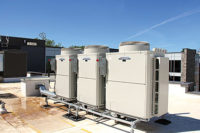Over the past year, the U.S. Department of Energy (DOE) has issued more than a dozen final rules that directly or indirectly impact the HVACR industry. Two, in particular, directly regulate minimum efficiency requirements for HVAC motors (see the DOE’s Motor Standards sidebar below).
While some in the industry believe regulating motors helps increase competition among manufacturers and spur technological advancements, others say the DOE is overregulating an industry that is already striving for efficiency. Meanwhile, the initial cost to comply will put pressure on manufacturers and, eventually, trickle down to consumers in the form of higher equipment prices.
A Little Competition
By introducing minimum efficiency standards for residential furnace fans, as well as energy conservation standards for commercial and light industrial electric motors, some say the DOE is encouraging competition to develop increasingly efficient products.
“I think this could level the playing field for U.S. manufacturers,” said Michael Delwiche, vice president of marketing and sales, Motors and Armatures Inc. (MARS). “It does ultimately make more sense for consumers to have the most efficient equipment they can get, and if the industry isn’t going to offer that, the government needs to step in.”
Scott Durfee, director of product management for the HVACR group, Nidec Motor Corp., said Nidec is ready to meet the DOE’s new furnace fan efficiency standard.
“The impact of the new furnace fan efficiency standards on the motor industry is very dynamic, and the changes are creating an excellent opportunity for companies with a strong base of technology, like Nidec, to excel,” he said.
Richard Peters, owner of FanHandler Inc., which provides advanced variable-speed control systems for the HVAC industry, believes the new standards will spur innovation among manufacturers.
“Competition within the HVAC industry should result in general product upgrades,” Peters said. “Some will adapt or copy readily available and up-to-date controls for enhancing comfort and efficiency from PSC [permanent split capacitor] motors and ECMs [electronically commutated motors].”
Paul Lin, manager of corporate energy marketing programs, Regal Beloit Corp., said his company strives to provide cutting-edge products while keeping its supply chain updated on the latest technologies.
“Reliability was one of the main concerns relative to the ECM technology in this rulemaking process,” Lin said. “With more than 20 years of providing ECM products, we are working to ensure our channel partners — contractors, distributors, and OEMs — understand the products Regal has to offer that can help them manage cost-effectiveness while maintaining a high level of reliability to address this standard.”
In Compliance
Throughout the rulemaking process, manufacturers often rely on trade associations to help represent their best interests while also providing input directly to regulatory agencies.
“Regal stays connected in several ways through its involvement with ACCA, HARDI [Heating, Air-conditioning, and Refrigeration Distributors International], AHRI [Air-Conditioning, Heating, and Refrigeration Institute], and direct work with OEM customers,” Lin said. “Throughout the year, Regal stays involved in various appliance efficiency standards on the federal and state level, and this furnace fan rulemaking was no exception.”
Regal also worked with NEMA (National Electrical Manufacturers Association) and energy advocates to help develop the next phase of standards for commercial and light industrial electric motors. “We felt there were significant loopholes in the current standard that were being leveraged, so we felt it was important to expand the scope of coverage versus increasing the efficiency bands as the Energy Independence and Security Act of 2007 had previously accomplished.”
To comply with the new standards, Regal and other manufacturers have “been redesigning products that do not currently meet the standard within the shortened compliance window,” Lin said. “With all the dialogue we had with the energy advocates and the DOE, we feel this is the correct path forward for all affected parties — motor manufacturers, OEMs, end users, and efficiency advocates.”
Durfee said Nidec was indifferent to the rulemaking process for furnace fan energy conservation standards, though company representatives were provided an opportunity to comment during the rulemaking process. “We are certainly seeing an increased activity level in our engineering group with the engagement of customers on new furnace platform redesigns,” he added.
Regulatory Burden
Though many agree energy conservation standards for motors help drive innovation, others say the DOE is overstepping its bounds and overregulating the industry. Delwiche said regulating components within a system is new territory for the DOE, and it’s a “slippery slope” that should be navigated with caution.
“You’re [regulating] fans now, and what’s next? Compressors? Those are the two big electricity-consuming motors,” he said. “I think that the DOE is trying to affect change, which, in the long term, is probably going to be a good thing, but I think that there’s got to be a little more thought put into it.”
Meanwhile, Peters said FanHandler was never contacted during the rulemaking process for furnace fan energy conservation standards. “It isn’t because we were hiding,” he said. “DOE could have Googled ‘HVAC variable speed.’ We introduced and have marketed Temperature Responsive Variable Speed since 1953.”
Peters also questioned DOE’s methods for testing motors that often behave differently when tested in a lab versus operating as part of a larger system. “Most energy studies we are familiar with are one-dimensional,” he said. “The particular piece of equipment is tested under lab conditions, and the focus is strictly on efficiencies under these circumstances.”
What’s Next?
Balancing feasibility, affordability, and reliability will be the biggest challenge for motor manufacturers, and many say they are ready to meet those demands. They also expect the DOE to continue to push though energy conservation standards for industry equipment.
“A study conducted by the International Energy Agency showed that electric motors consumed 45 percent of electricity globally,” Lin said. “Electric motors will continue to be a focus for regulation, but recent dialogue has focused on system efficiency. Even the furnace fan regulation is a system efficiency regulation as factors such as the blower and the cabinet design factor into the fan efficiency rating (FER).”
Durfee said furnaces of the future will have a higher content of ECMs, which will increase prices on HVAC systems and require technicians to understand the technology in order to service the equipment.
“There is always a tradeoff between higher efficiencies and equipment costs,” Durfee said.
“We must always be concerned about the affordability of HAC equipment. … You also have HVAC systems with a higher level of electronics and system integration that must be supported by the contractor in the field. The increased level of complexity requires more training to ensure the equipment can be effectively maintained and serviced.”
Instead of viewing energy conservation standards as a burden, Lin said it is “an opportunity for the best, most cost-effective, and most reliable solutions to be implemented” throughout the industry. “We also see this as an opportunity to introduce new technologies that will differentiate from the minimum standard,” he said.
“In general, if the HVAC industry can provide more energy-efficient products that make homes more comfortable, you’ll find that people want to enjoy those benefits,” Lin added. “Most people do not want to have the HVAC system from the house they grew up in, just like I don’t want to use my old Palm Pilot versus my iPhone 6.”
SIDEBAR: DOE’s Motor Standards
On June 25, 2014, the Department of Energy (DOE) issued a new standard for furnace fans that is predicted to save approximately 3.99 quads of energy, reduce carbon pollution by up to 34 million metric tons (equivalent to the annual electricity use of 4.7 million homes), and save Americans more than $9 billion in home electricity bills through 2030. Residential furnace fans incorporated in the products listed below and manufactured on and after July 3, 2019, shall have a fan energy rating (FER) value that meets or is less than the following standards:

Standards for covered residential furnace fans effective July 3, 2019.
*Furnace fans incorporated into hydronic air handlers, small-duct high-velocity (SDHV) modular blowers, SDHV electric furnaces, and CAC/HP indoor units are not subject to the standards listed in this table.
** QMax is the airflow, in cfm, at the maximum airflow-control setting measured using the final DOE test procedure at 10 CFR part 430, subpart B, appendix AA.
Information courtesy of DOE, http://bit.ly/ResFurnaceFans.
Commercial and Industrial Electric Motors
In May, the DOE issued a final rule establishing energy conservation standards for commercial and industrial electric motors ranging in size from 200-500 hp. The effective date of this rule was July 28, 2014, and compliance with the standards established for commercial and industrial electric motors in the final rule is required starting on June 1, 2016.
Estimated energy savings would result in cumulative greenhouse gas emission reductions of approximately 395 million metric tons of CO2, 1.88 million tons of methane, 673,000 tons of sulfur dioxide, 498,000 tons of nitrogen oxides, and 0.8 tons of mercury. The cumulative reduction in CO2 emissions through 2030 amounts to 96 metric tons. The DOE estimates the industry’s net present value (INPV) for manufacturers of electric motors is $3.48 billion. Under today’s standards, DOE expects manufacturers may lose up to 10 percent of their INPV, which is approximately $348 million.
Information courtesy of the DOE. For detailed information about the energy conservation standards for commercial and industrial electric motors, visit http://bit.ly/ElectricMotorStandards.
Publication date: 12/8/2014
Want more HVAC industry news and information? Join The NEWS on Facebook, Twitter, and LinkedIn today!









